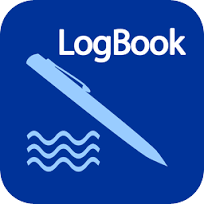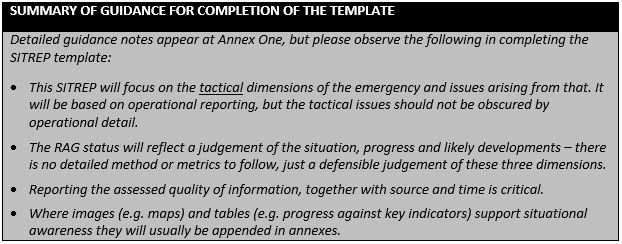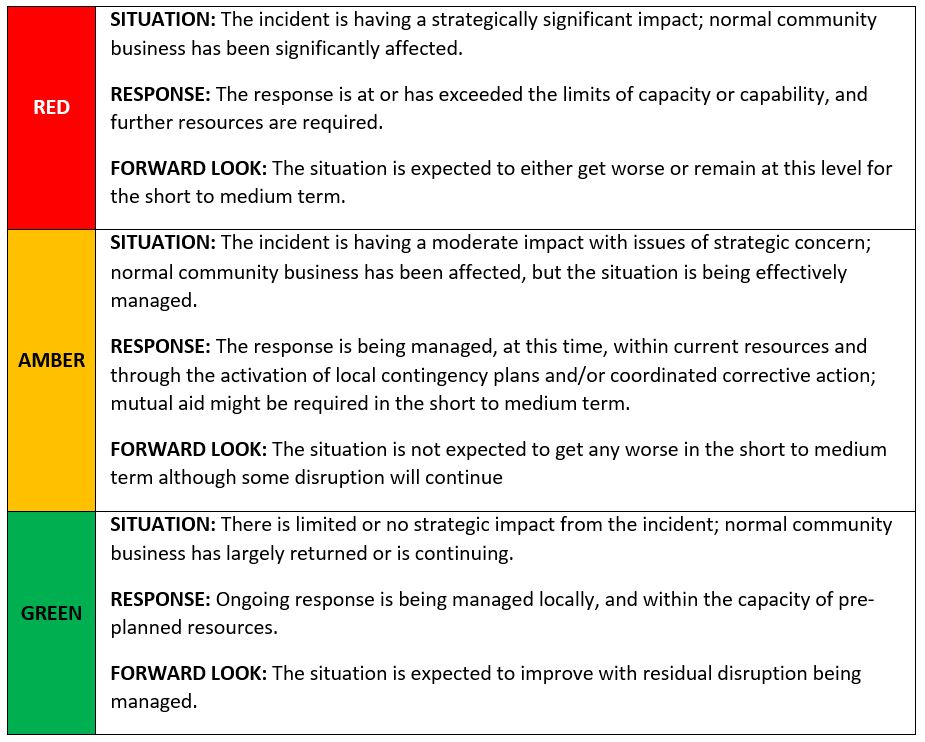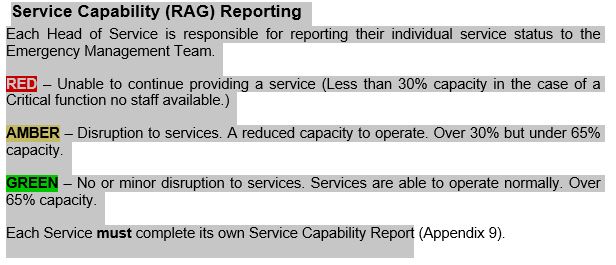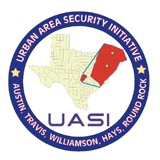Title Page
-
Document No.
-
Reason for activation
-
Before taking any action talk through the proposed actions with either the HoS or Deputy Chief Exec.
-
OFFICIAL SENSITIVE
-
Conducted for
-
Conducted on
-
Prepared by
-
Location
Initial Notification
-
Date
-
Incident
-
Time of Notification
-
Method of Notification
- SMS
- Radio
- Face to Face Meeting
- Telephone
- Video Phone
- Paged Message
- Group SMS
-
Message of Notification
-
Time Message was Actioned
Incident Detail
-
M - Major Incident Declared
-
Declared By
- Other
- Met Office
- Police
- Fire
- Ambulance
- Local Authority - Upper Tier
- Local Authority - Lower Tier
- Coastguard
- Environment Agency
- Primary care
- Acute Care
- Military
- Voluntary Aid
- Harbout/Airport
- HSE
- Phone Provider
- Gas Distribution
- Electricity
- Water
- Highways England
- Railways
- Crawley Borough Internal
- Strategic Coordinating Group
- Tactical Coordinating Group
-
Detail
-
Time of Declaration
-
E - Exact Location of the Incident
-
T - Type of Incident
- Road Traffic
- Weather
- Flood
- Fire
- Building
- Disease
- Wind
- Railways
- Aircraft
- Explosion
- Evacuation
- Terrorism
- Criminal
- Trapped
- Chemical
- Smoke
- Gas
- Other
-
Type
-
H - Hazards Present of Suspected
- H1. Domestic Gas Escape
- H2. Oxyacetelyne / LPG
- H3. Bulk Fuel
- H4. Chemical
- H5. Biological
- H6. Radiation
- H7. Explosives or Bombs
- H8. Water
- H9. Electricity
- H10 Other
-
Hazard Detail
-
A - Access Routes (inc RVP etc)
-
Access
-
N - Number and Type of Casualty
-
E - Emergency Services On Site
- Other
- Met Office
- Police
- Fire
- Ambulance
- Local Authority - Upper Tier
- Local Authority - Lower Tier
- Coastguard
- Environment Agency
- Primary care
- Acute Care
- Military
- Voluntary Aid
- Harbout/Airport
- HSE
- Phone Provider
- Gas Distribution
- Electricity
- Water
- Highways England
- Railways
- Crawley Borough Internal
- Strategic Coordinating Group
- Tactical Coordinating Group
-
Emergency Services Requested
- Other
- Met Office
- Police
- Fire
- Ambulance
- Local Authority - Upper Tier
- Local Authority - Lower Tier
- Coastguard
- Environment Agency
- Primary care
- Acute Care
- Military
- Voluntary Aid
- Harbout/Airport
- HSE
- Phone Provider
- Gas Distribution
- Electricity
- Water
- Highways England
- Railways
- Crawley Borough Internal
- Strategic Coordinating Group
- Tactical Coordinating Group
-
What Local Authority Assistance is required.
-
Other Notes
-
Call/Meeting Terminated
Essential Contacts List
- Contact
-
Organization
- Other
- Met Office
- Police
- Fire
- Ambulance
- Local Authority - Upper Tier
- Local Authority - Lower Tier
- Coastguard
- Environment Agency
- Primary care
- Acute Care
- Military
- Voluntary Aid
- Harbout/Airport
- HSE
- Phone Provider
- Gas Distribution
- Electricity
- Water
- Highways England
- Railways
- Crawley Borough Internal
- Strategic Coordinating Group
- Tactical Coordinating Group
-
Name
-
undefined
- Land Line
- Mobile
- Pager
- Other
-
Land Line
-
Mobile
-
Pager
-
Other
Log
-
Incident Activation
Serial
-
Time of Log Entry
-
Select date
-
Entry
- Log Entry
- Log Reviewed by Post Holder
- General Notes
- Decision
- address
- sketch
- photo
- weather
- Conversation
- METHANE
- ETHANE
- Personnel
- Briefing
- Local Authority Assets Required
- Formal Meeting
- Local SitRep
- Wide SituationReport
- River Level Telemetry
- Date Change
- TAG
-
Username: Crawley BC
Password: J3790
http://www.timeview2.net/ -
Latest Alarm Screen
Location
-
Telemetry from
-
Alarm Screen
-
Camera Image
-
Image Timestamp
Review Signature
-
The above entries are confirmed as correct
-
PDF Copy of this Log is to be exported to
epo@crawley.gov.uk
LOG
-
-
Information/Message to post holder
-
From
-
Their Contact Details
-
Action by Post Holder
-
Add drawing
-
Add media
-
Action Confirmed
CRAWLEY BOROUGH COUNCIL SITUATION REPORT
-
Select date
-
Sit Rep Number
-
Author
-
RAG Status
-
Situation Overview
-
Summary of Response
-
Look Forward
-
Resourcing
-
Add media
TACTICAL COORDINATING GROUP (TCG) SITUATION REPORT
-
Select date
-
Sit Rep Number
-
TCG Chair
-
Author
-
First Report or Guidance needed?
-
-
ANNEX ONE: GUIDANCE NOTES FOR COMPLETING THE SITREP TEMPLATE
Purpose, audience and completion of the SITREP
• The primary audience for the SITREP is the SCG itself.
• Additional audiences will include DCLG Emergency Room, COBR, neighbouring or otherwise affected SCGs and other stakeholders requiring strategic situational awareness.
• The SITREP will usually be drafted in advance of an SCG meeting, then completed and disseminated up/down/sideways as required following the meeting, with agreed actions.
• The SCG and its support staff should determine who completes the SITREP. The GLO/GLT will have a role in synthesising strategic information from the completed SITREP for onward transmission to COBR.
Logic of the template
• The template is a starting point for situational reporting at the strategic level
• The template can be adapted if necessary to fit the specifics of a situation
• Adaptation should not however be done to reflect personal preferences
Protocols for updating
• Material that is new or revised since the previous SITREP should be in red text
• The date/time/source of material should be prominent and clear
RAG status
• The RAG status is an honest and defensible appraisal of three dimensions of the emergency: a) the situation, b) the response to it and c) foreseeable developments.
• Because three dimensions are being combined into a single indicator, and in the absence of a prescribed method of doing so, the RAG status will reflect the collective judgement of the SCG.
• There is no merit in ‘talking up’ or taking an unrealistically optimistic view of where things stand and how they are projected to develop.
• Reading the relevant entry should adequately explain the RAG status given.
• Indicators of the three levels are defined as follows: -
Reporting provenance and quality
• The source/time and assessed quality of information should be clearly and prominently reported.
• Where critical uncertainties (i.e. factors that are unknown, but which have the potential to strategically alter the situation if they become known) exist they should be clearly identified and associated risks set out.
Defining concepts and terms for common understanding
• Where common understanding of a concept or term is necessary for shared situational awareness it should be clearly explained.
• Common understanding of terms cannot be assumed – terms should be defined
• Where agreed definitions exist these should normally be adopted and explained (e.g. there is a definition of ‘flood’ in the Water Flood and Water Management Act 2010).
• Acronyms and abbreviations should be minimised, and always explained at their first use in every issue of the SITREP
Reporting provenance and quality
• The source/time and assessed quality of information should be clearly and prominently reported.
• Where critical uncertainties (i.e. factors that are unknown, but which have the potential to strategically alter the situation if they become known) exist they should be clearly identified and associated risks set out.
Defining concepts and terms for common understanding
• Where common understanding of a concept or term is necessary for shared situational awareness it should be clearly explained.
• Common understanding of terms cannot be assumed – terms should be defined
• Where agreed definitions exist these should normally be adopted and explained (e.g. there is a definition of ‘flood’ in the Water Flood and Water Management Act 2010).
• Acronyms and abbreviations should be minimised, and always explained at their first use in every issue of the SITREP
Examples of content for each of the template sections / cells, including numbers involved, nature and severity of impacts and details as required (NOTE that this is an indicative list, not a comprehensive checklist to report against):
• Key locations (including grid reference or postcode)
• Relevant timings (e.g. timescale to mobilise assets or shut down a facility)
• Impact on health and humanitarian assistance
o Casualties / fatalities / missing persons
o Public Health / healthcare / welfare
o Mortuary capacity and operations
o Humanitarian assistance - Rest Centre and other facilities occupancy
o Primary and Secondary healthcare
o Social care
• Impact on essential services
o Telecommunications
o Electricity
o Gas
o Fuel supply
o Water supply
o Sanitation
o Sewage
o Waste management
o Burials/cremations
o Transport, aviation, maritime, rail, road, bus
o Postal services
o Status of reserves or alternative supplies
• Impact on communities:
o Impact on private dwellings
o Impact on public premises / assets
o Homecare
o Vulnerable people/groups
o Evacuation
o Housing and temporary accommodation
o Impact on community transport
o Impact on education
o Community response: nature and extent
o Engagement by the voluntary sector
• Economic impact:
o Businesses directly and/or indirectly affected (numbers or range if estimate)
o Supply chain consequences
o Impact on workforce
o Impact on tourism
o Rural economy (farms, food production sector, etc.)
• Environmental impact
o Water contamination
o Land contamination
o Air pollution
o Waste management issues which may be associated with the response
o Impact on agriculture
o Food availability/supplies
o Animal welfare
• Criminal Justice Issues
o Prisons
o Public order/crime
o Courts
o Protection of property
o Community safety / community cohesion Issues
• Issues relating to response and capability
o Specified, implied, essential, and potential tasks
o Weather: forecast and associated risks
o Current status of resources / capabilities (dispositions and availability)
o Mutual aid / military support
o Key considerations and assumptions
o Constraints on the operation (e.g. time, resources, sustainment, distance, demand and duration)
o Recommended timelines
o Contingency planning
o Capacity of local tier to respond
o Finance
• Emerging recovery issues
o Infrastructure and essential services repair and/or reconnection
o Financial assistance (e.g. business rate or council tax relief)
o Insurance issues
o Any bureaucracy or “red tape” challenges
o Bellwin Scheme
o Future resilience investment
o Lessons (to be) identified -
Situation Overview
-
Summary of the Response
-
Look Forward
-
Resource Issues
-
Strategy
-
Working Strategy
-
Overarching Aim
-
Objectives
-
Media Strategy
-
Emergency Services RAG Status
-
Police
-
Fire
-
Ambulance
-
Other
-
Local Authority(ies)
-
State the name of the Authority in the Notes Column
-
For the RAG Status of the Crawley Council see RAG Status number
-
Health
-
Public Health England
-
Local Public Health
-
NHS England
-
Environment Agency
-
Forecast
-
Likely impacts and risks arising
-
Current situation
-
Met Office
-
Forecast
-
Likely impacts and risks arising
-
Current situation
-
Transport
-
Highways England
-
Network Rail
-
Highways Authority (see LA)
-
Train Operating Company
-
Other
-
Utilities
-
Gas
-
Water
-
Telecoms
-
Other
-
Electricity
-
Voluntary Sector
-
Enter the name of the organisation in the notes column
-
Military
-
Overview
By Unit
-
Enter the name of the unit or by capability area in the notes column
-
Summary of other involved groups
-
STAC
-
Humanitarian Assistance
-
Recovery Group
-
Other responders
-
Enter the Organisation name in the notes column
-
Other Issues not covered Elsewhere
-
Date and Time of Next expected update
Meeting
-
Date and time of meeting
-
Organisation calling the meeting
- Other
- Met Office
- Police
- Fire
- Ambulance
- Local Authority - Upper Tier
- Local Authority - Lower Tier
- Coastguard
- Environment Agency
- Primary care
- Acute Care
- Military
- Voluntary Aid
- Harbout/Airport
- HSE
- Phone Provider
- Gas Distribution
- Electricity
- Water
- Highways England
- Railways
- Crawley Borough Internal
- Strategic Coordinating Group
- Tactical Coordinating Group
-
Method of Attendance
- SMS
- Radio
- Face to Face Meeting
- Telephone
- Video Phone
- Paged Message
- Group SMS
-
Chair
-
1. Declaration of items for urgent attention
-
2. Decision on items for urgent attention
-
BREAK OUT TIME TO ACTION ANY URGENT ISSUES AS AGREED ABOVE
-
2a. Introduction of Attendees, roles and Responsibilities
-
3 Command Structure issues
-
3a. Confirmation of Gold Strategy & METHANE update
-
4 Review and Agree Minutes of Previous Meeting
-
5. Advice from Tactical Advisory Group (TAG)
-
6. Specific Areas at risk (people, places, environment)
-
7. Business Continuity Issues
-
8. Update on Significant Issues or Incidents
-
9. Intelligence Update
-
10. Threat levels and Security Issues
-
11. CBRN Preparedness
-
12. Community Tensions/Impact
-
13. Media messages
-
14. Mapping & Data requests
-
15. UAVs/restricted airspace
-
16. VIP/Family Visits
-
17. Logistics & Finance Cell/Mutual Aid (Inc Assets & Capabilities)
-
18. Handover Phase/Exit Strategies/Notification of stand down
-
19 Review of Actions
-
20. AOB
-
21 Place of Next Meeting
-
21a Date and Time of Next Meeting
-
Meeting Closed
-
Method of meeting
- SMS
- Radio
- Face to Face Meeting
- Telephone
- Video Phone
- Paged Message
- Group SMS
-
Chair
-
1. Declaration of items for urgent attention
-
2. Decision on items for urgent attention
-
BREAK OUT TIME TO ACTION ANY URGENT ISSUES AS AGREED ABOVE
-
2a. Introduction of Attendees, roles and Responsibilities
-
3. Review and agree minutes of previous meeting
-
4. Review outstanding actions
-
4a Update on casualty numbers
-
5. Update on strategic situation (SITREP) METHANE Report (update)
-
6. Review and agree strategic aims (see Annex D), objectives, decisions and membership
-
7. Key Considerations
I. Determine policy for implementation by Tactical Commanders
II. Assess and arrange for adequate resources
III. Prioritise allocation of resources to Tactical Commanders
IV. Warning & Informing
V. Communications and Media Strategy
VI. Implement adequate financial controls
VII. Government Liaison/VIP Visits
VIII. Liaise with neighbouring police forces and/or regional partner agencies
IX. Coordinate communications both internally and to the public
X. Provide liaison with the media at a strategic level
XI. Appoint a Briefing and Information Officer
XII. Identification of the vulnerable
XIII. Identification of the deceased
XIV. Investigation / Public Inquiries
XV. Recovery Phase
XVI. Military Aid
XVII. Legal Issues
XVIII. TAG Advice
XIX. Consider requesting STAC
XX. Staff Welfare -
7. Key Considerations
-
8. Organisational Updates
-
9. I. Discuss and agree strategic decisions II. Confirmation and allocation of actions III. Consider whether any additional support is required
-
10. Agree frequency of meetings
-
10 Date and Time of Next Meeting
-
10. Time Meeting Closed
-
Method of meeting
- SMS
- Radio
- Face to Face Meeting
- Telephone
- Video Phone
- Paged Message
- Group SMS
-
Chair
-
Contact Details
Reports
-
Organisation report notes for
- Other
- Met Office
- Police
- Fire
- Ambulance
- Local Authority - Upper Tier
- Local Authority - Lower Tier
- Coastguard
- Environment Agency
- Primary care
- Acute Care
- Military
- Voluntary Aid
- Harbout/Airport
- HSE
- Phone Provider
- Gas Distribution
- Electricity
- Water
- Highways England
- Railways
- Crawley Borough Internal
- Strategic Coordinating Group
- Tactical Coordinating Group
-
Name
-
Notes
Review Signature
-
The above entries are confirmed as correct
-
PDF Copy of this Log is to be exported to epo@crawley.gov.uk
-
The end of
- Monday
- Tuesday
- Wednesday
- Thursday
- Friday
- Saturday
- Sunday
Log restarted on
-
Day
- Monday
- Tuesday
- Wednesday
- Thursday
- Friday
- Saturday
- Sunday
-
Date/TIme
-
Location
Location
-
Select date
-
Add location
-
Mileage
Sketch
-
Sketch of Location
-
Select date
-
Sketch of;...
-
Add drawing
Photo
-
Select date
-
Photograph of;...
-
Image
ETHANE Report
-
Select date
-
Exact Location
-
Exact Location
-
Exact Location - Ensure GPS tagging is turned on
-
Exact Location
-
Type of Incident
-
The nature of the incident, including how many vehicles, buildings and so on are involved
- Road Traffic
- Weather
- Flood
- Fire
- Building
- Disease
- Wind
- Railways
- Aircraft
- Explosion
- Evacuation
- Terrorism
- Criminal
- Trapped
- Chemical
- Smoke
- Gas
- Other
-
Description
-
Description
-
Hazards - both present and potential
-
undefined
- H1. Domestic Gas Escape
- H2. Oxyacetelyne / LPG
- H3. Bulk Fuel
- H4. Chemical
- H5. Biological
- H6. Radiation
- H7. Explosives or Bombs
- H8. Water
- H9. Electricity
- H10 Other
-
Access
-
Annotated Screen print from Google Eath
-
Route Diagram
-
Numbers of Casualties
-
How Many
-
How Many
-
How Many
-
Emergency Services - Category 1
-
Police
-
Fire
-
Ambulance
-
Local Authority - Upper Tier
-
Local Authority - District / Borough
-
MCA
-
NHS
-
Category 2 responders
-
Highways England
-
Strategic Health Authority
-
Gas Distributers
-
Water & Sewerage
-
Electricity Providers
-
Communications Providers
-
Rail Operators / Network Rail
-
HSE
-
Port Operator
Major Emergency Declared METHANE
-
Select date
-
Major Emergency; Has a Major Emergency been Declared? If so by whom?
-
Exact Location
-
Exact Location
-
Exact Location - Ensure GPS tagging is turned on
-
Exact Location
-
Type of Incident
-
The nature of the incident, including how many vehicles, buildings and so on are involved
- Road Traffic
- Weather
- Flood
- Fire
- Building
- Disease
- Wind
- Railways
- Aircraft
- Explosion
- Evacuation
- Terrorism
- Criminal
- Trapped
- Chemical
- Smoke
- Gas
- Other
-
Description
-
Description
-
Hazards - both present and potential
-
undefined
- H1. Domestic Gas Escape
- H2. Oxyacetelyne / LPG
- H3. Bulk Fuel
- H4. Chemical
- H5. Biological
- H6. Radiation
- H7. Explosives or Bombs
- H8. Water
- H9. Electricity
- H10 Other
-
Access
-
Annotated Screen print from Google Eath
-
Route Diagram
-
Numbers of Casualties
-
How Many
-
How Many
-
How Many
-
Emergency Services - Category 1
-
Police
-
Fire
-
Ambulance
-
Local Authority - Upper Tier
-
Local Authority - District / Borough
-
MCA
-
NHS
-
Category 2 responders
-
Highways England
-
Strategic Health Authority
-
Gas Distributers
-
Water & Sewerage
-
Electricity Providers
-
Communications Providers
-
Rail Operators / Network Rail
-
HSE
-
Port Operator
Decision
-
Select date
-
Decision Made
-
Reasoning Behind the Decision
-
Initials
Conversation notes
-
Select date
-
Media Used
- SMS
- Radio
- Face to Face Meeting
- Telephone
- Video Phone
- Paged Message
- Group SMS
-
Logging in
www.24x.com
Username: CBC38826
Password: XUXKM
http://www.24x.com -
When Transmitted
-
When Transmitted
-
Message was read
-
Message was read
-
Content
-
Response sent?
-
When the response was sent
-
Content of response
-
When Transmitted
-
When Transmitted
-
Message was read
-
Message was read
-
Content
-
Copy of email for evidence
-
Response sent?
-
When the response was sent
-
Content of response
-
Conversation with....
-
Content Notes
Personnel
-
Select date
-
Agency
- Other
- Met Office
- Police
- Fire
- Ambulance
- Local Authority - Upper Tier
- Local Authority - Lower Tier
- Coastguard
- Environment Agency
- Primary care
- Acute Care
- Military
- Voluntary Aid
- Harbout/Airport
- HSE
- Phone Provider
- Gas Distribution
- Electricity
- Water
- Highways England
- Railways
- Crawley Borough Internal
- Strategic Coordinating Group
- Tactical Coordinating Group
-
Name - Include Particular Company or Division if relevant
-
Contact Details
Briefing
-
Select date
-
Location of next Briefing
-
When the Briefing is due. (be there 5 minutes early)
-
Briefing Agency
- Other
- Met Office
- Police
- Fire
- Ambulance
- Local Authority - Upper Tier
- Local Authority - Lower Tier
- Coastguard
- Environment Agency
- Primary care
- Acute Care
- Military
- Voluntary Aid
- Harbout/Airport
- HSE
- Phone Provider
- Gas Distribution
- Electricity
- Water
- Highways England
- Railways
- Crawley Borough Internal
- Strategic Coordinating Group
- Tactical Coordinating Group
-
Briefing Notes
Local Authority Assistance required.
-
Select date
-
Assets Requested
- Dangerous Structure - Building Control
- Site Clearance - Waste Management
- Evacuee Transport
- Workforce Transport
- Rest Centre
- Humanitarian Assistance Centre
- Pollution Issues
- Identifying Vulnerable
- Bio Waste Removal
- Other
-
1. Roll call #1
-
2. Urgent matters
-
3. Reason for the teleconference
-
4. Is this a Major Incident?
-
5. Met Office Update
-
6. EA Update
-
7. Partner Updates
-
8. 4x4 Transport Coordination Cell Activation
-
9. Issues to address now
-
10. AOB
-
11. Next meeting
-
a. Do we need one?
-
b. When, time etc
Flagged Entry
-
-
Select date
-
undefined
-
Add media
-
Is a decision required?
Decision
-
-
Select date
-
Decision Made
-
Reasoning Behind the Decision
-
Initials
-
-
Is an action required?
-
Flagged Entry?
Flagged Entry
Crawley Borough Situation Report (SitRep)
-
RAG Status request made
-
RAG Status Guidance
undefined
Situation Report
-
SitRep update time
-
Number
-
Author
-
First Report or Guidance Needed
-
Situation Overview
-
Summary of Response
-
Look Forward
-
Resource Issues
-
RAG Status
Personnel
- Personnel Required
-
Select date
-
Area of requirement
- Incident Liaison
- Rest Centre
- Emergency Control Centre
- NewRequest
- other
Updated or New Request
-
Select date
-
Other personnel required
-
Incident Liaison<br>
-
Craig Forshaw - 447908783004
-
Indicated Availability
-
John Braidley 447881813043
-
Indicated Availability
-
Terry Hardie 447809685250
-
Indicated Availability
-
Tony Baldock 447919076845
-
Indicated Availability
-
Environmental Health Duty Phone 447807072977
-
Indicated Availability
-
Ana Mackay RC Manager / ILO Trained with Tim and Tony 447527578479
-
Indicated Availability
-
Name
-
Indicated Availability
Activated staff
-
-
Name of activated ILO & time of response
-
Date/Time of activation
-
Rest Centre
Get RC Staff to indicate availability -
Gail Weeks RC Manager 447708189755
-
Indicated Availability
-
Ana Mackay RC Manager 447527578479
-
Indicated Availability
-
Name
-
Indicated Availability
Activated staff
-
-
Name of activated Rest Centre Staff member & time of response
-
Date/Time of activation
-
Name and phone number of nominated rep from Legal & Democratic Services
-
Name and phone number of nominated rep fromFinance, Revenues & Benefits
-
Name and phone number of nominated rep from Strategic Housing
-
Name and phone number of nominated rep from Economic and Environmental Services
-
Name and phone number of nominated rep from Partnership Services
-
Name and phone number of nominated rep from People & Technology
-
Name and phone number of nominated rep from Community Services
-
Name and phone number of nominated rep from Crawley Homes
-
ECC Support
-
Name and Phone Number of Nominated Emergency Control Centre Manager
-
Name and Phone Number of Nominated Communications Assistant
-
Name and Phone Number of Nominated Mapping Assistant
-
Name and Phone Number of Nominated Loggist
Green = Available throughout the projected emergerncy
Amber = Available for part of the time (Note available times here)
Red= Unavailable
Logging Contract
- To be completed every time that a decision maker or Loggist take on the role or there is a change in personnel
-
Is there a separate Decision Maker/Loggist role?
-
This Contract is to be agreed and signed by both the Loggist and the member of staff being logged (decision Maker).
Each Point should be discussed prior to the commencement of logging and on each occasion there is a change in the loggist or the decision maker. -
Date / Time of the Contract
-
Loggist
-
Decision Maker
-
Organisation / Service Area
-
Location
Points for discussion and agreement Check when discussed
-
The decision maker will make it clear when an entry is to be logged by the loggist, by using the term; "for the log"
-
If the loggist feels there is something thsat possibly needs logging, it is agreed that they can interrupt the decision maker and ask; "is that for the log?"
-
Where there are exhibits the decision maker will ensure that the loggist is made aware and that a copy is made available for the loggist to archive
-
The loggist will be given time to clearly write the entry required by the member of staff being logged.
-
The loggist and decision maker will agree that entries will be "signed off" as a minimum after every 10 entries. More often may be agreed
-
Does the decision maker want to sign off more often?
-
State the agreed timeframe.
-
The decision maker will give the loggist adequate time at the start of any meeting to plot the table plan and clearly log names and designation of every attendee.
-
The decision maker and loggist will go through all entries for their joint period of working together and sign off prior to handing over to another person.
-
If the loggist feels that information being logged is ambiguous, the decision maker accepts that the loggist can challenge them.
-
Decision Maker
-
Loggist
End of Log
Debrief Notes
-
Name and Role of respondant
-
Successes
-
Not Successful
-
Actions and Recommendations
-
Further Comments
Log Completion
-
Add signature
